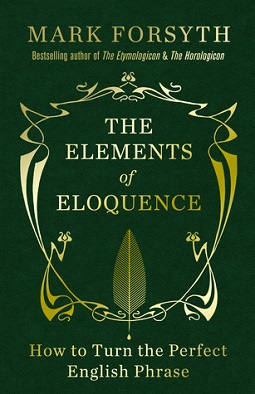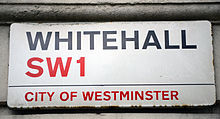An adverb is a word or an expression that generally modifies a verb, adjective, another adverb, determiner, clause, preposition, or sentence. Adverbs typically express manner, place, time, frequency, degree, level of certainty, etc., answering questions such as how, in what way, when, where, to what extent. This is called the adverbial function and may be performed by single words (adverbs) or by multi-word adverbial phrases and adverbial clauses.
English grammar is the set of structural rules of the English language. This includes the structure of words, phrases, clauses, sentences, and whole texts.

Metonymy is a figure of speech in which a concept is referred to by the name of something closely associated with that thing or concept.

Synecdoche is a type of metonymy; it is a figure of speech in which a term for a part of something is used to refer to the whole, or vice versa. The term is derived from Ancient Greek συνεκδοχή (sunekdokhḗ) 'simultaneous understanding'.
Pleonasm is redundancy in linguistic expression, such as "black darkness," "burning fire," "the man he said," or "vibrating with motion." It is a manifestation of tautology by traditional rhetorical criteria and might be considered a fault of style. Pleonasm may also be used for emphasis, or because the phrase has become established in a certain form. Tautology and pleonasm are not consistently differentiated in literature.

In rhetoric, a rhetorical device, persuasive device, or stylistic device is a technique that an author or speaker uses to convey to the listener or reader a meaning with the goal of persuading them towards considering a topic from a perspective, using language designed to encourage or provoke an emotional display of a given perspective or action. They seek to make a position or argument more compelling than it would otherwise be.
In rhetoric, zeugma and syllepsis are figures of speech in which a single phrase or word joins different parts of a sentence.
In literature and writing, stylistically elements are the use of any of a variety of techniques to give an auxiliary meaning, ideas, or feeling to the literalism or written.
In linguistics and grammar, a sentence is a linguistic expression, such as the English example "The quick brown fox jumps over the lazy dog." In traditional grammar, it is typically defined as a string of words that expresses a complete thought, or as a unit consisting of a subject and predicate. In non-functional linguistics it is typically defined as a maximal unit of syntactic structure such as a constituent. In functional linguistics, it is defined as a unit of written texts delimited by graphological features such as upper-case letters and markers such as periods, question marks, and exclamation marks. This notion contrasts with a curve, which is delimited by phonologic features such as pitch and loudness and markers such as pauses; and with a clause, which is a sequence of words that represents some process going on throughout time. A sentence can include words grouped meaningfully to express a statement, question, exclamation, request, command, or suggestion.
Asyndeton is a literary scheme in which one or several conjunctions are deliberately omitted from a series of related clauses. Examples include veni, vidi, vici and its English translation "I came, I saw, I conquered". Its use can have the effect of speeding up the rhythm of a passage and making a single idea more memorable. Asyndeton may be contrasted with syndeton and polysyndeton, which describe the use of one or multiple coordinating conjunctions, respectively.

The Rhetorica ad Herennium is the oldest surviving Latin book on rhetoric, dating from the late 80s BC. It was formerly attributed to Cicero or Cornificius, but is in fact of unknown authorship, sometimes ascribed to an unnamed doctor.
Parallelism is a rhetorical device that compounds words or phrases that have equivalent meanings so as to create a definite pattern. This structure is particularly effective when "specifying or enumerating pairs or series of like things". A scheme of balance, parallelism represents "one of the basic principles of grammar and rhetoric".

Owing to its origin in ancient Greece and Rome, English rhetorical theory frequently employs Greek and Latin words as terms of art. This page explains commonly used rhetorical terms in alphabetical order. The brief definitions here are intended to serve as a quick reference rather than an in-depth discussion. For more information, click the terms.

This glossary of literary terms is a list of definitions of terms and concepts used in the discussion, classification, analysis, and criticism of all types of literature, such as poetry, novels, and picture books, as well as of grammar, syntax, and language techniques. For a more complete glossary of terms relating to poetry in particular, see Glossary of poetry terms.

A literary trope is the use of figurative language, via word, phrase or an image, for artistic effect such as using a figure of speech. Keith and Lundburg describe a trope as "a substitution of a word or phrase by a less literal word or phrase". The word trope has also undergone a semantic change and now also describes commonly recurring or overused literary and rhetorical devices, motifs or clichés in creative works. Literary tropes span almost every category of writing, such as poetry, film, plays, and video games.

In rhetoric, a scheme is a type of figure of speech that relies on the structure of the sentence, unlike the trope, which plays with the meanings of words.
In rhetoric, parallel syntax is a rhetorical device that consists of repetition among adjacent sentences or clauses. The repeated sentences or clauses provide emphasis to a central theme or idea the author is trying to convey. Parallelism is the mark of a mature language speaker.

The Elements of Eloquence: How to Turn the Perfect English Phrase is a non-fiction book by Mark Forsyth published in 2013. The book explains classical rhetoric, dedicating each chapter to a rhetorical figure with examples of its use, particularly in the works of William Shakespeare. Forsyth argues the power of Shakespeare's language was a result of studying formal rhetoric, and highlights their use through Shakespeare's development.
Poetic devices are a form of literary device used in poetry. Poems are created out of poetic devices via a composite of: structural, grammatical, rhythmic, metrical, verbal, and visual elements. They are essential tools that a poet uses to create rhythm, enhance a poem's meaning, or intensify a mood or feeling.

![The cartoon is a pun on the word Jamaica, whose pronunciation [dZ@'meIk@] is a homonym to the clipped form of "Did you make her?" Jamaica her own idea.png](http://upload.wikimedia.org/wikipedia/commons/thumb/9/9f/Jamaica_her_own_idea.png/280px-Jamaica_her_own_idea.png)





